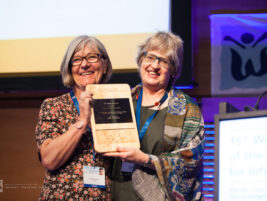Beyond the importance and the relevance of its content to our infant mental health field, the book, «The Baby and the Couple, « has a special dimension, conveyed by its format. Indeed, it is almost in live dialogue, back and forth, between theoretical concepts, objective observation, and clinical work. It is the end-product of a creative co-venture, in itself the reflection of a long cooperative alliance between Elisabeth Fivaz-Depeursinge, both clinician and researcher in developmental and family system psychology, located in Lausanne (Switzerland), and Diane A. Philipp, a family therapist and child psychiatrist, trained at the Watch, Wait, and Wonder therapeutic approach at Toronto Sick Children’s Hospital (Canada).
The main theoretical concepts of primary, secondary inter-subjectivity, triangular and multi-person communication, cohesive co-parenting, excluding, child-centered, and competitive co-parenting, are clearly explained and are then illustrated by very detailed observations of infants and their families, thus conveying the feeling of watching a well-coordinated dance between theory and real clinical life. Too often, we see a frustrating dichotomy between theoreticians and clinicians. This book shows the richness of the interplay between them: for instance, observing the actual impact of the baby’s coping at 3 months of age when both parents struggle to work together, challenging early the classical theory of the infant’s capacity for one-to-one primary inter-subjectivity.
Throughout reading the book, we get to know several «practicing families» through longitudinal observations from pregnancy to toddlerhood and early childhood (5 years). The authors’ story-like way of describing the families’ Prenatal Lausanne Trilogue Play, the Lausanne Trilogue Play (LTP), or the Lausanne Family Play (LFP), at the lab, at home, in shopping malls…make them almost real. It is like reading three «suspense» stories, where one knows the beginning, and wonders how it will unfold. Lucas and Sarah show us how flexible, warm, inclusive family representations develop and are verbally expressed; they also show us, at 5 years of age, how the capacity to take others’ perspectives (ToM), the autonomous ageappropriate functioning, positive affect and low aggressiveness, are predicted from their respective parents’ cohesive alliance, starting in pregnancy. In contrast, Charlotte, in an excluding co-parenting type, Alex, in a child-at-center co-parenting type, and Miriam, in a competitive coparenting family, illustrate quite vividly how infants cope, more or less adaptively, with non-cohesive co-parenting, during their first five years of life. It is well known that babies have an active role in the development of the family communication pattern, through a direct impact on his/her parents.
Also throughout reading the book, one comes to appreciate the richness of (LTP), as an easy to teach and family-friendly research tool that has engendered many «sisters», such as the Prenatal LTP, the family Picnic Game (PNG), the Lausanne Narrative Trilogue Play (LNP) for 5 year olds and older, or the LFP for parents with more than one child.
Two therapeutic applications of the LTP are described, the Developmental Systems Consultation and Trial Interventions. The central core of the LTP is its physicality; the use of video-feedback helps at triggering reflection and mentalization. The Reflective Family Play is an example of a «double» creative adaptation, as it combines the LTP with its physicality (non- verbal mode), structure and video-feedback and the reflective (verbal mode) child-lead stance of the Wait Watch and Wonder approach.
Our young therapists are often overwhelmed by the presence of both parents and baby, and prefer to work with parents only, or with one parent and the baby: «How can you listen and observe the three of them…each pulls your attention, you can’t really listen to what they are saying»!. In our own experience at our Infant Mental Health Unit, the LTP and its derivatives, including the video-feedback, are very useful as structuring the session, for the therapist as well as for the families. It directs the clinician’s attention to specific parameters of the triadic interaction, such as engagement, role distribution, joint focus and affect sharing. Then, these may become the basis for encouraging reflective functioning.
To conclude, in my view, this book is a real resource for any clinician, not only in the field of infant mental health, and researcher in human sciences. It needs to be «simply present» on each infant mental health researcher and practitioner’s bookshelf!
Authors
Keren, Miri,
MD, President of WAIMH,
ofkeren@zahav.net.il
Israel








